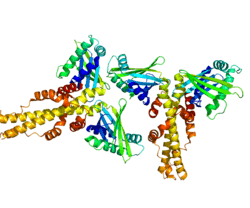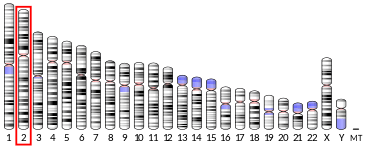Non-homologous end-joining factor 1
Non-homologous end-joining factor 1 (NHEJ1), also known as Cernunnos or XRCC4-like factor (XLF), is a protein that in humans is encoded by the NHEJ1 gene.[4] XLF was originally discovered as the protein mutated in five patients with growth retardation, microcephaly, and immunodeficiency.[5] The protein is required for the non-homologous end joining (NHEJ) pathway of DNA repair. Patients with XLF mutations also have immunodeficiency due to a defect in V(D)J recombination, which uses NHEJ to generate diversity in the antibody repertoire of the immune system. XLF interacts with DNA ligase IV and XRCC4 and is thought to be involved in the end-bridging or ligation steps of NHEJ. The yeast (Saccharomyces cerevisiae) homolog of XLF is Nej1.[6]
Phenotypes
In contrast to the profound immunodeficiency phenotype of XLF deletion in humans, deletion of XLF alone has a mild phenotype in mice.[7] However, combining a deletion of XLF with deletion of the ATM kinase causes a synthetic defect in NHEJ, suggesting partial redundancy in the function of these two proteins in mice.[8]
Structure
XLF is structurally similar to XRCC4, existing as a constitutive dimer with an N-terminal globular head domain, an alpha-helical stalk, and an unstructured C-terminal region (CTR).[9]
Interactions
XLF has been shown to interact with XRCC4,[10] and with Ku protein,[11] and it can also interact weakly with DNA.[12][13] Co-crystal structures of XLF and XRCC4 suggest that the two proteins can form hetero-oligomers via head-to-head interaction of alternating XLF and XRCC4 subunits.[14][15][16] These XRCC4-XLF filaments have been proposed to bridge DNA prior to end ligation during NHEJ. Formation of XRCC4-XLF oligomers can be disrupted by interaction of the C-terminal domain of XRCC4 with the BRCT domain of DNA ligase IV.[14]
Hematopoietic stem cell aging
Deficiency of NHEJ1 in mice leads to premature aging of hematopoietic stem cells as indicated by several lines of evidence including evidence that long-term repopulation is defective and worsens over time.[17] Using a human induced pluripotent stem cell model of NHEJ1 deficiency, it was shown that NHEJ1 has an important role in promoting survival of the primitive hematopoietic progenitors.[18] These NHEJ1 deficient cells possess a weak NHEJ1-mediated repair capacity that is apparently incapable of coping with DNA damages induced by physiological stress, normal metabolism, and ionizing radiation.[18]
References
- GRCh38: Ensembl release 89: ENSG00000187736 - Ensembl, May 2017
- "Human PubMed Reference:". National Center for Biotechnology Information, U.S. National Library of Medicine.
- "Mouse PubMed Reference:". National Center for Biotechnology Information, U.S. National Library of Medicine.
- "Entrez Gene: NHEJ1 nonhomologous end-joining factor 1".
- Buck D, Malivert L, de Chasseval R, Barraud A, Fondanèche MC, Sanal O, Plebani A, Stéphan JL, Hufnagel M, le Deist F, Fischer A, Durandy A, de Villartay JP, Revy P (Jan 2006). "Cernunnos, a novel nonhomologous end-joining factor, is mutated in human immunodeficiency with microcephaly". Cell. 124 (2): 287–99. doi:10.1016/j.cell.2005.12.030. PMID 16439204.
- Callebaut I, Malivert L, Fischer A, Mornon JP, Revy P, de Villartay JP (May 2006). "Cernunnos interacts with the XRCC4 x DNA-ligase IV complex and is homologous to the yeast nonhomologous end-joining factor Nej1". The Journal of Biological Chemistry. 281 (20): 13857–60. doi:10.1074/jbc.C500473200. PMID 16571728.
- Li G, Alt FW, Cheng HL, Brush JW, Goff PH, Murphy MM, Franco S, Zhang Y, Zha S (Sep 2008). "Lymphocyte-specific compensation for XLF/cernunnos end-joining functions in V(D)J recombination". Molecular Cell. 31 (5): 631–40. doi:10.1016/j.molcel.2008.07.017. PMC 2630261. PMID 18775323.
- Zha S, Guo C, Boboila C, Oksenych V, Cheng HL, Zhang Y, Wesemann DR, Yuen G, Patel H, Goff PH, Dubois RL, Alt FW (Jan 2011). "ATM damage response and XLF repair factor are functionally redundant in joining DNA breaks". Nature. 469 (7329): 250–4. doi:10.1038/nature09604. PMC 3058373. PMID 21160472.
- Andres SN, Modesti M, Tsai CJ, Chu G, Junop MS (Dec 2007). "Crystal structure of human XLF: a twist in nonhomologous DNA end-joining". Molecular Cell. 28 (6): 1093–101. doi:10.1016/j.molcel.2007.10.024. PMID 18158905.
- Deshpande RA, Wilson TE (Oct 2007). "Modes of interaction among yeast Nej1, Lif1 and Dnl4 proteins and comparison to human XLF, XRCC4 and Lig4". DNA Repair. 6 (10): 1507–16. doi:10.1016/j.dnarep.2007.04.014. PMC 2064958. PMID 17567543.
- Yano K, Morotomi-Yano K, Wang SY, Uematsu N, Lee KJ, Asaithamby A, Weterings E, Chen DJ (Jan 2008). "Ku recruits XLF to DNA double-strand breaks". EMBO Reports. 9 (1): 91–6. doi:10.1038/sj.embor.7401137. PMC 2246615. PMID 18064046.
- Tsai CJ, Chu G (Jun 2013). "Cooperative assembly of a protein-DNA filament for nonhomologous end joining". The Journal of Biological Chemistry. 288 (25): 18110–20. doi:10.1074/jbc.M113.464115. PMC 3689955. PMID 23620595.
- Lu H, Pannicke U, Schwarz K, Lieber MR (Apr 2007). "Length-dependent binding of human XLF to DNA and stimulation of XRCC4.DNA ligase IV activity". The Journal of Biological Chemistry. 282 (15): 11155–62. doi:10.1074/jbc.M609904200. PMID 17317666.
- Andres SN, Vergnes A, Ristic D, Wyman C, Modesti M, Junop M (Feb 2012). "A human XRCC4-XLF complex bridges DNA". Nucleic Acids Research. 40 (4): 1868–78. doi:10.1093/nar/gks022. PMC 3287209. PMID 22287571.
- Wu Q, Ochi T, Matak-Vinkovic D, Robinson CV, Chirgadze DY, Blundell TL (Oct 2011). "Non-homologous end-joining partners in a helical dance: structural studies of XLF-XRCC4 interactions". Biochemical Society Transactions. 39 (5): 1387–92, suppl 2 p following 1392. doi:10.1042/BST0391387. PMID 21936820.
- Ropars V, Drevet P, Legrand P, Baconnais S, Amram J, Faure G, Márquez JA, Piétrement O, Guerois R, Callebaut I, Le Cam E, Revy P, de Villartay JP, Charbonnier JB (Aug 2011). "Structural characterization of filaments formed by human Xrcc4-Cernunnos/XLF complex involved in nonhomologous DNA end-joining". Proceedings of the National Academy of Sciences of the United States of America. 108 (31): 12663–8. doi:10.1073/pnas.1100758108. PMC 3150875. PMID 21768349.
- Avagyan S, Churchill M, Yamamoto K, Crowe JL, Li C, Lee BJ, Zheng T, Mukherjee S, Zha S (2014). "Hematopoietic stem cell dysfunction underlies the progressive lymphocytopenia in XLF/Cernunnos deficiency". Blood. 124 (10): 1622–5. doi:10.1182/blood-2014-05-574863. PMC 4155271. PMID 25075129.
- Tilgner K, Neganova I, Singhapol C, Saretzki G, Al-Aama JY, Evans J, Gorbunova V, Gennery A, Przyborski S, Stojkovic M, Armstrong L, Jeggo P, Lako M (2013). "Brief report: a human induced pluripotent stem cell model of cernunnos deficiency reveals an important role for XLF in the survival of the primitive hematopoietic progenitors". Stem Cells. 31 (9): 2015–23. doi:10.1002/stem.1456. PMID 23818183.
Further reading
- Pastwa E, Malinowski M (May 2007). "Non-homologous DNA end joining in anticancer therapy". Current Cancer Drug Targets. 7 (3): 243–50. doi:10.2174/156800907780618284. PMID 17504121.
- Dai Y, Kysela B, Hanakahi LA, Manolis K, Riballo E, Stumm M, Harville TO, West SC, Oettinger MA, Jeggo PA (Mar 2003). "Nonhomologous end joining and V(D)J recombination require an additional factor". Proceedings of the National Academy of Sciences of the United States of America. 100 (5): 2462–7. doi:10.1073/pnas.0437964100. PMC 151363. PMID 12604777.
- Buck D, Malivert L, de Chasseval R, Barraud A, Fondanèche MC, Sanal O, Plebani A, Stéphan JL, Hufnagel M, le Deist F, Fischer A, Durandy A, de Villartay JP, Revy P (Jan 2006). "Cernunnos, a novel nonhomologous end-joining factor, is mutated in human immunodeficiency with microcephaly". Cell. 124 (2): 287–99. doi:10.1016/j.cell.2005.12.030. PMID 16439204.
- Ahnesorg P, Smith P, Jackson SP (Jan 2006). "XLF interacts with the XRCC4-DNA ligase IV complex to promote DNA nonhomologous end-joining". Cell. 124 (2): 301–13. doi:10.1016/j.cell.2005.12.031. PMID 16439205.
- Callebaut I, Malivert L, Fischer A, Mornon JP, Revy P, de Villartay JP (May 2006). "Cernunnos interacts with the XRCC4 x DNA-ligase IV complex and is homologous to the yeast nonhomologous end-joining factor Nej1". The Journal of Biological Chemistry. 281 (20): 13857–60. doi:10.1074/jbc.C500473200. PMID 16571728.
- Revy P, de Villartay JP (2006). "[Cernunnos, a novel DNA repair factor essential for the immune system]". Médecine/Sciences. 22 (6–7): 569–70. doi:10.1051/medsci/20062267569. PMID 16828027.
- Cantagrel V, Lossi AM, Lisgo S, Missirian C, Borges A, Philip N, Fernandez C, Cardoso C, Figarella-Branger D, Moncla A, Lindsay S, Dobyns WB, Villard L (Apr 2007). "Truncation of NHEJ1 in a patient with polymicrogyria". Human Mutation. 28 (4): 356–64. doi:10.1002/humu.20450. PMID 17191205.
- Lu H, Pannicke U, Schwarz K, Lieber MR (Apr 2007). "Length-dependent binding of human XLF to DNA and stimulation of XRCC4.DNA ligase IV activity". The Journal of Biological Chemistry. 282 (15): 11155–62. doi:10.1074/jbc.M609904200. PMID 17317666.
- Tsai CJ, Kim SA, Chu G (May 2007). "Cernunnos/XLF promotes the ligation of mismatched and noncohesive DNA ends". Proceedings of the National Academy of Sciences of the United States of America. 104 (19): 7851–6. doi:10.1073/pnas.0702620104. PMC 1859989. PMID 17470781.
- Deshpande RA, Wilson TE (Oct 2007). "Modes of interaction among yeast Nej1, Lif1 and Dnl4 proteins and comparison to human XLF, XRCC4 and Lig4". DNA Repair. 6 (10): 1507–16. doi:10.1016/j.dnarep.2007.04.014. PMC 2064958. PMID 17567543.
- Wu PY, Frit P, Malivert L, Revy P, Biard D, Salles B, Calsou P (Nov 2007). "Interplay between Cernunnos-XLF and nonhomologous end-joining proteins at DNA ends in the cell". The Journal of Biological Chemistry. 282 (44): 31937–43. doi:10.1074/jbc.M704554200. PMID 17720816.


